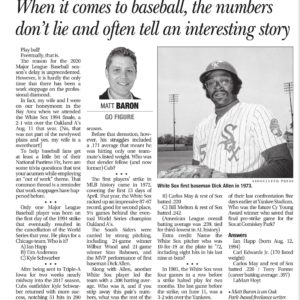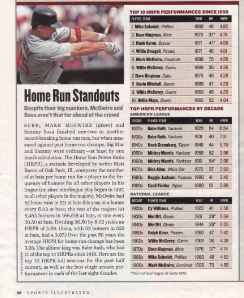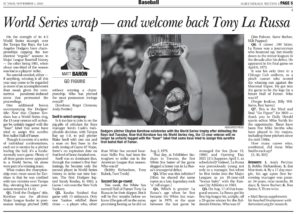 Over the past 15 years, my writing has increasingly been outside the journalism realm.
Over the past 15 years, my writing has increasingly been outside the journalism realm.
At the same time, I have characterized myself not so much as a “former journalist” but as a “recovering” one. Truth is, having begun as a 15-year-old writing for my hometown newspaper over 35 years ago, I may have largely left journalism, but it has never left me. I gravitate toward most any chance to write for publications.
Such an opportunity arose early this year, shortly before the COVID-19 pandemic struck here in the United States. Daily Herald sports editor Mike Smith, a newsroom colleague in the 1990s, approached me with an idea of writing a column revolving around baseball statistics. Mike was aware of my passion for baseball, including my creation of the Home Run Power Ratio, a home run inflation index that Sports Illustrated featured (below) in October 1999.

Though the Major League Baseball season was delayed for nearly four months, that didn’t dissuade me from launching the column. After all, there are plenty of data points to plumb throughout baseball’s history–so that’s precisely (and gleefully) what I did until the season finally began last July 23rd.
In All: 32 “Go Figure” Columns
In all, I wrote 32 columns, mostly focused on the two Chicago teams, the Cubs and the White Sox. The inaugural column (above) featured 1972 American League Most Valuable Player Dick Allen, among others, as I introduced a trivia-question format. The finale (below) was a “World Series wrap” and offered a bit of a ’21 preview with a numerical take on Tony La Russa’s hiring as White Sox manager.
In between were 30 numbers-crunching looks at the game.
They included how the two Chicago baseball teams have fared on Easter Sundays over their respective century-plus histories, a flashback to Dave Kingman’s Mother’s Day 1978 dominance over the Los Angeles Dodgers, observations on the luck required for no-hitters, and a chronicling of myriad statistical oddities and observations.
On occasion, I have gotten into the prognostication business, such as forecasting the Colorado Rockies’ Charlie Blackmon (hitting .500 at the time) would not come close to batting .400, even during the shortened season. (I was right; Blackmon slumped and barely eked out an average over .300.)
The bottom line: in the midst of a real downer of a year, these columns have provided me with much-needed weekly rays of sunshine. It’s my hope that they have served a similar purpose for readers. Here’s looking forward to more Go Figure columns next season!
Related Posts:
Irony, Tragedy in Photograph of Sosa & Bonds
Amid Steroid Era, Aaron’s Legacy Shines
